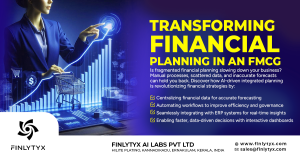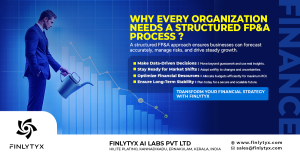
Data has become an extremely valuable resource across all industries. Thus, Data Science and Business intelligence has been very effectively used in solving many real-world problems and is being widely adopted across all industries to make more insightful and intelligent decision-making.
The banking industry is usually not looked at as an industry that uses technology a lot. However, this is slowly changing as bankers are starting to use technology for better decision-making. Banking industries are rich with data. Used or unused, there is a huge amount of data in these sectors. The rapid changes that have been happening in this sector such as changes in technology, changes in people’s expectations, and changes in market behavior are some of the reasons for the sudden increased interest in the use of data analytics and business intelligence in this sector.
As banks compete to differentiate themselves and gain a competitive advantage, the need for properly managing and using these data is very important. Banks record millions of business transactions daily and these entries are real-time in nature. The amount of data generated by banks is not just huge but also real-time. Structuring and recording these data is useless until and unless there is a plan to make use of such a large volume of data. Many banks are working on improving their data analytics using business intelligence tools to predict emerging trends that can affect their businesses. Therefore, identifying the connection between the data and possible results is very relevant in today’s complex business world.
Data analytics in banking can be used for numerous purposes.
- Understand their audience and customers better
- Analysis of customer spending & investment pattern
- Risk assessment and mitigation
- Fraud Detection and Security
- Product Customization
- Determine interest rates and forecast Net Interest Income (NII)
- Manage overall funds situation and Fund Transfer Pricing (FTP)
- Compliance and Market segmentation
- Maximize sales while minimizing cost by optimizing revenue
- Financial reporting
- Planning, Budgeting and Forecasting
- Improve customer satisfaction and loyalty
- Improved marketing and remarketing campaign planning
- Loan amount prediction/classification
Predictive Analysis in Banking
Predictive analytics is redefining the modern banking industry. Using various predictive analysis methods, the banking sector can use the insights they gather to provide consumers with value-driven and cost effective services that are customized for each individual.
Predictive analytics uses a wide variety of techniques such as statistics, data mining, data modeling, machine learning, and artificial intelligence. These techniques are broadly adopted for identifying financial uncertainty, accidents, strategic management errors, legal liabilities, fraud detection, and risk assessments. Predictive analytics finds common data patterns by leveraging statistical modeling, data mining, and machine learning technologies, and determines the possibilities of these patterns happening again.
According to IBM, 27% of banks and financial markets pilot and implement big data activities to turn data into actionable insights and then into profits., Here are the most common examples of how predictive analytics can be used to improve financial and banking services.
Customer Segmentation
Banking and financial markets CEOs claim their top priority is to better understand, predict, and give customers the needful and quality of services they need. Analytics can help banks classify customers based on their economic criteria, which helps to determine their exact needs and challenges. Predictive Analytics looks into customers’ service performance and spending and targets the best product offerings to the most appropriate customer group. Advanced or predictive analysis even helps to determine what the customer might need next or what they are not interested in. It is important to differentiate between customers that make the money and customers that don’t.
Fraud Detection
Predictive analytics tools can help businesses easily detect any strange and unusual behaviors and prevent fraud before happening. If there is a sudden increase in the expenditure of a cautious customer, there is a chance that the customer’s card might have been stolen and is being used by fraudsters. Since analytics deals with data, it has enough information to actually predict and detect such frauds based on the patterns and investment behavior of customers.
Minimizes risks
One of the leading applications of predictive analytics is risk management. These models use a broader range of data sources and result in a minimum rate of default losses, thereby reducing the risk of losing customers to competitors due to a slow process. Moreover, banks can also find patterns with their customers thereby reducing an upcoming risk. According to each customer’s historical data, financial companies can accurately evaluate the risks involved in a customer with crediting or project financing. This helps the bank to get an idea about the degree of risk they are going to deal with once a particular customer avails the service.
Conclusion
Big data analytics, AI, and Business intelligence are today’s revolutionary technologies that provide a new sight to the world to look at things in a better, insightful, and innovative way.
The term ‘Data Science’ popularity & focus started from the year 2001 and it took less than two decades for it to become the trend it is today. Finance was the first industry to understand data science advantages. Today, Data Science and business intelligence (BI) are used in almost all industries that are trying to leverage their potential, and this number is only going to multiply as data science and BI technology become more valid, reliable, and cost-effective.
Analytics in banking has a lot to do with business intelligence converting data into usable knowledge. In banking, especially with predictive analytics and big data, it has become a lot easier to figure out the opportunities which would fetch the highest response rates among customers. As a huge amount of data is generated, the need to extract useful information is becoming very important. Data analytics is therefore key to improving the business.
We at Finlytyx help our customers identify opportunities by leveraging their internal and external data. We leverage emerging technologies such as Power BI, Qlik, and Tableau in the data and analytics space to maximize the business impact while engaging us for the data analytics services. An interactive dashboard that consolidates the KPIs covering key aspects of their business will make the senior executives’ life easy moreover it proactively takes their attention to the critical business elements which can be a business value or an eye opener to serious operational risk. We see a large trend in moving towards Power BI for executive dashboard and data analytics developments, this is due to the cost-effectiveness, ease of deployment, free-of-cost cloud adoption, mobile access features, etc.
Connect with Finlytyx for a detailed business case study; we have built industry-specific analytics & dashboard that can be easily accommodated to meet your business purpose.
Author,
Ashly Sunny, Data Scientist & Visualiser
@ Finlytyx AI Labs Pvt Ltd.
Recent Blogs
-
 AI, Automation & Digitalization Revolutionizing Financial Modeling in the Quick Service Restaurant & Retail Indus Introduction
AI, Automation & Digitalization Revolutionizing Financial Modeling in the Quick Service Restaurant & Retail Indus Introduction -
 Solving Financial Consolidation Challenges with Jedox
Solving Financial Consolidation Challenges with Jedox -
 Transforming Financial Planning In an FMCG.
Transforming Financial Planning In an FMCG. -
 Why a Systematic Approach to FP&A is Essential for a Predictable Business Growth
Why a Systematic Approach to FP&A is Essential for a Predictable Business Growth -
 From Generative AI to AGI
From Generative AI to AGI
Request for services
Find out more about how we can help your organization navigate its next. Let us know your areas of interest so that we can serve you better.
Share your project details with us and receive a free consultation.
 Ashly Sunny, Data Scientist & Visualiser
Ashly Sunny, Data Scientist & Visualiser 



